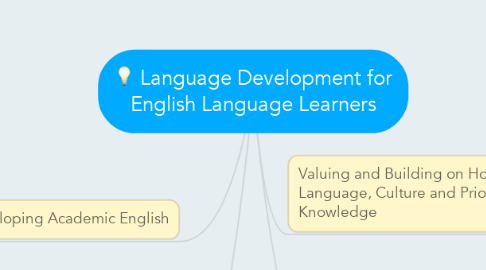
1. Interacting in Meaningful and Intellectually Challenging Ways
1.1. Establishing routines and expectations for engaging in collaborative oral discussions with peers
1.2. Carefully construct questions that promote extended discussions about academic content
1.3. Provide appropriate linguistic support
2. Developing Academic English
2.1. Academic English refers to the language used in school to help students develop content knowledge and the language students are expected to use to convey their understanding of this knowledge (complex literary processes include interpreting, discussing, analyzing, evaluating, writing)
2.1.1. Vocabulary
2.1.1.1. 1. Rich and varied language experiences
2.1.1.2. 2. Teaching individual academic words
2.1.1.3. 3. Teaching word learning strategies
2.1.1.4. 4. Fostering word consciousness and language play
2.1.2. Grammatical and Discourse-Level Understandings
2.1.2.1. Teaching about the grammatical patterns found in particular disciplines has been shown to help EL's reading comprehension and writing proficiency
2.1.2.2. Language and content are inextricably linked
2.1.2.3. It is effective to teach EL students about how language works to achieve different purposes in a variety of contexts and disciplines
3. Scaffolding
3.1. Temporary supportive frameworks that are future orientated
3.1.1. Substantial, moderate and light scaffolding depending on the level of English Language Proficiency and what skills student has already mastered
3.1.2. Planned Scaffolding allows teachers to prepare in advance during lesson and curriculum planning
3.1.2.1. Constructing good questions that promote critical thinking and extended discourse
3.1.2.2. Frequently checking for understanding during instruction
3.1.2.3. Choosing texts carefully for specific purposes
3.1.3. Just In Time Scaffolding flexibly attends to EL's as they interact with content and language
3.1.3.1. Adjusting instruction on the spot based on frequent checking for understanding
3.1.3.2. Paraphrasing a student's response and including target academic as a model
4. Valuing and Building on Home Language, Culture and Prior Knowledge
4.1. Benefits of bilingualism:
4.1.1. Provide a powerful scaffold to English literacy
4.1.2. Metalinguistic and metacognitive benefits

